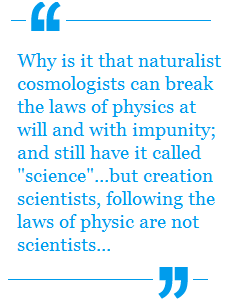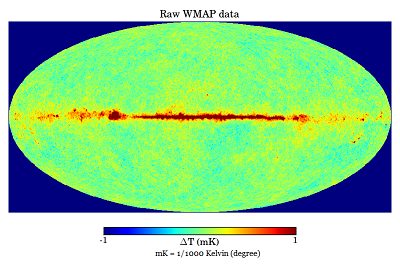Nobody likes double standards. There have been long, sometimes bloody, and in some cases – ongoing – battles to make the same rules apply to everyone. This is true in the work place – most want equal pay for equal work. This is true in race relations – no one in this day and age will abide Jim Crow laws or making African Americans sit at the back of the bus. It’s true in sports – no one like cheaters – however they choose to break the rules thus applying a double standard. Why then does it not apply to the sciences of cosmology and evolution? Since the focus of this article is on distant starlight, I will focus in on the double standards used in cosmology, but understand the same points apply equally to evolutionary “scientists” who give explanations which are no more than smoke and mirrors.1
Naturalistic Cosmologists regularly breaks the laws of physics
 |
Why is it that naturalist cosmologists can break the laws of physics at will and with impunity; and still have it be called “science” (not pseudo-science), but creationist scientists, following the laws of physics are not scientists, and are told they’re not practicing science? No such thing happens you say? Let’s dismiss the notion that creation scientists are treated fairly, and with respect. If they were, there would be no need for the recent article by Creation Ministries titled: Fallacy: creationists can’t be scientists;2 or Ben Stein’s recent movie on the censure faced by scientists who don’t toe the evolutionary line and instead support intelligent design.3 |
The fact that creation scientists are not given the respect they deserve is already well documented. What is not as well documented is the ability for materialist scientists to play fast and loose with the laws of physics and still be considered “scientists” contributing “valid” theories. Consider the following conversation:
Big Bang Theorist: The universe began 13.7 billion years ago when a singularity which consisted of all the energy that will ever exist, which did not exist previously, suddenly exploded into existence out of nowhere (and nowhen4) creating time and space in an event commonly known as the big bang. The universe has been rapidly expanding ever since.
Creationist: No, the universe began about 6,000 years by an act of God as recorded in Genesis 1.1 “In the beginning, God created the heavens and the earth.”
Big Bang Theorist: If the universe is only 6,000 years old, how do you explain distant stars whose light has taken million of years to reach earth?
Creationist: There are a number of theories that explain that. How do you explain the big bang’s Horizon problem?
Big Bang Theorist: That’s easy: Inflation.
Creationist: Inflation is not the answer – many scientists don’t believe it, and simply put: the whole theory is impossible. As for distant starlight, there are theories on how to resolve that apparent problem.
For those defending a young earth, creationist world view, this conversation is likely a familiar one. But before I point to some of the answers regarding how distant star light can be seen in a young creation, let’s first look at the many problems for big bang cosmology. Let me start with an overview of the big big as provided by Morgan Freeman from his series, Through the Wormhole
“With the addition of inflation, the big bang became a cohesive three act play.
Act one – a singularity pops into existence out of nowhere and nowhen and containing in one single dot all the energy that will ever be in our universe.
Act two – Inflation suddenly takes hold. An unimaginably rapid expansion of space smooths the spreading out of that energy bringing order to the universe. It’s now a massive soup of evenly expanding plasma.
Act three – the universe cools. Matter begins to clump together under the force of gravity.
Eventually forming stars, galaxies and planets.5
Inflation has been mentioned a couple of times now. If you think it has something to do with your money, the economy or the amount of air in your car’s tire, you clearly need this overview.
The Big Bang theory: Playing fast and loose with the laws of physics
You don’t have to get deep into the big bang theory before scientists have to start playing fast and loose with the recognized laws of physics.
Problem 1: The Singularity
The first one – in act one – is a familiar one. “A singularity pops into existence out of nowhere and nowhen.” Stop. This is impossible. Nothing exists. From nothing comes nothing. How can a “singularity” which consists of “all the energy that will ever exist” be created? It defies the law of conservation of energy which states in a closed system, energy can be neither created nor destroyed.
Problem 2: “Popping into Existence”
Just as importantly how can it “pop into existence” when nothing exists? What is there to pop into? Neither space nor time exists at this point. As our narrator Morgan Freeman points out, there is no “where” for it to pop into, and there is no “when” to pop into since time does not yet exist. Thus there is no “existence” for it to pop into. This breaks the law of causality which states in the cause-effect chain of events – effects follow causes (not the other way around) and those causes are separate from the effects. This is essentially the argument made by the Kalam Cosmological argument for the existence of God. Yet big bang cosmologists essentially want you to believe that the singularity is self caused – because again there is nothing in existence, according to the big bang theorists, so nothing could have caused it but itself.
So here were are in the “first act” of the big bang, we haven’t even gotten to the difficult problems, and already 2 fundamental laws of physics have been broken.
Paul Steinhardt, the Albert Einstein professor of physics at Princeton University explains how physicists allow themselves to get away with this nonsense:
“This is normally referred to as the cosmic singularity, some sort of breakdown in the laws of physics, which in the standard big bang theory you simply ignore.”6
They simply ignore it. Pretend it isn’t a problem or it doesn’t matter. And they call that science, and themselves scientists?
Problem 3: The Horizon problem
The Horizon problem is yet another show stopping issue for the big bang. Big bang theorists will tell you it has been “resolved” by sleight of hand tricks involving the laws of physics with the aforementioned theory of inflation. But before delving into the problems with inflation, you need to understand the problem7 that inflation “solves” for the big bang. Continue Reading

